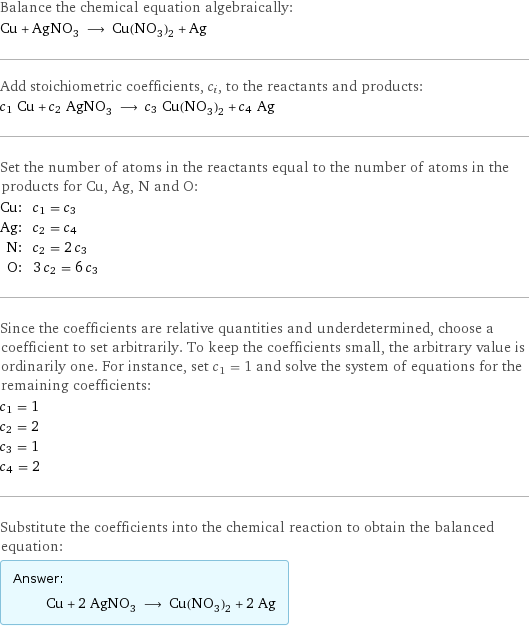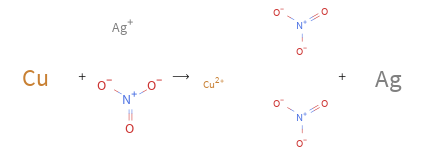Input interpretation

Cu (copper) + AgNO_3 (silver nitrate) ⟶ Cu(NO_3)_2 (copper(II) nitrate) + Ag (silver)
Balanced equation

Balance the chemical equation algebraically: Cu + AgNO_3 ⟶ Cu(NO_3)_2 + Ag Add stoichiometric coefficients, c_i, to the reactants and products: c_1 Cu + c_2 AgNO_3 ⟶ c_3 Cu(NO_3)_2 + c_4 Ag Set the number of atoms in the reactants equal to the number of atoms in the products for Cu, Ag, N and O: Cu: | c_1 = c_3 Ag: | c_2 = c_4 N: | c_2 = 2 c_3 O: | 3 c_2 = 6 c_3 Since the coefficients are relative quantities and underdetermined, choose a coefficient to set arbitrarily. To keep the coefficients small, the arbitrary value is ordinarily one. For instance, set c_1 = 1 and solve the system of equations for the remaining coefficients: c_1 = 1 c_2 = 2 c_3 = 1 c_4 = 2 Substitute the coefficients into the chemical reaction to obtain the balanced equation: Answer: | | Cu + 2 AgNO_3 ⟶ Cu(NO_3)_2 + 2 Ag
Structures

+ ⟶ +
Names

copper + silver nitrate ⟶ copper(II) nitrate + silver
Equilibrium constant
![Construct the equilibrium constant, K, expression for: Cu + AgNO_3 ⟶ Cu(NO_3)_2 + Ag Plan: • Balance the chemical equation. • Determine the stoichiometric numbers. • Assemble the activity expression for each chemical species. • Use the activity expressions to build the equilibrium constant expression. Write the balanced chemical equation: Cu + 2 AgNO_3 ⟶ Cu(NO_3)_2 + 2 Ag Assign stoichiometric numbers, ν_i, using the stoichiometric coefficients, c_i, from the balanced chemical equation in the following manner: ν_i = -c_i for reactants and ν_i = c_i for products: chemical species | c_i | ν_i Cu | 1 | -1 AgNO_3 | 2 | -2 Cu(NO_3)_2 | 1 | 1 Ag | 2 | 2 Assemble the activity expressions accounting for the state of matter and ν_i: chemical species | c_i | ν_i | activity expression Cu | 1 | -1 | ([Cu])^(-1) AgNO_3 | 2 | -2 | ([AgNO3])^(-2) Cu(NO_3)_2 | 1 | 1 | [Cu(NO3)2] Ag | 2 | 2 | ([Ag])^2 The equilibrium constant symbol in the concentration basis is: K_c Mulitply the activity expressions to arrive at the K_c expression: Answer: | | K_c = ([Cu])^(-1) ([AgNO3])^(-2) [Cu(NO3)2] ([Ag])^2 = ([Cu(NO3)2] ([Ag])^2)/([Cu] ([AgNO3])^2)](../image_source/e2f90cc338eb9ca7640ae654c32c85a8.png)
Construct the equilibrium constant, K, expression for: Cu + AgNO_3 ⟶ Cu(NO_3)_2 + Ag Plan: • Balance the chemical equation. • Determine the stoichiometric numbers. • Assemble the activity expression for each chemical species. • Use the activity expressions to build the equilibrium constant expression. Write the balanced chemical equation: Cu + 2 AgNO_3 ⟶ Cu(NO_3)_2 + 2 Ag Assign stoichiometric numbers, ν_i, using the stoichiometric coefficients, c_i, from the balanced chemical equation in the following manner: ν_i = -c_i for reactants and ν_i = c_i for products: chemical species | c_i | ν_i Cu | 1 | -1 AgNO_3 | 2 | -2 Cu(NO_3)_2 | 1 | 1 Ag | 2 | 2 Assemble the activity expressions accounting for the state of matter and ν_i: chemical species | c_i | ν_i | activity expression Cu | 1 | -1 | ([Cu])^(-1) AgNO_3 | 2 | -2 | ([AgNO3])^(-2) Cu(NO_3)_2 | 1 | 1 | [Cu(NO3)2] Ag | 2 | 2 | ([Ag])^2 The equilibrium constant symbol in the concentration basis is: K_c Mulitply the activity expressions to arrive at the K_c expression: Answer: | | K_c = ([Cu])^(-1) ([AgNO3])^(-2) [Cu(NO3)2] ([Ag])^2 = ([Cu(NO3)2] ([Ag])^2)/([Cu] ([AgNO3])^2)
Rate of reaction
![Construct the rate of reaction expression for: Cu + AgNO_3 ⟶ Cu(NO_3)_2 + Ag Plan: • Balance the chemical equation. • Determine the stoichiometric numbers. • Assemble the rate term for each chemical species. • Write the rate of reaction expression. Write the balanced chemical equation: Cu + 2 AgNO_3 ⟶ Cu(NO_3)_2 + 2 Ag Assign stoichiometric numbers, ν_i, using the stoichiometric coefficients, c_i, from the balanced chemical equation in the following manner: ν_i = -c_i for reactants and ν_i = c_i for products: chemical species | c_i | ν_i Cu | 1 | -1 AgNO_3 | 2 | -2 Cu(NO_3)_2 | 1 | 1 Ag | 2 | 2 The rate term for each chemical species, B_i, is 1/ν_i(Δ[B_i])/(Δt) where [B_i] is the amount concentration and t is time: chemical species | c_i | ν_i | rate term Cu | 1 | -1 | -(Δ[Cu])/(Δt) AgNO_3 | 2 | -2 | -1/2 (Δ[AgNO3])/(Δt) Cu(NO_3)_2 | 1 | 1 | (Δ[Cu(NO3)2])/(Δt) Ag | 2 | 2 | 1/2 (Δ[Ag])/(Δt) (for infinitesimal rate of change, replace Δ with d) Set the rate terms equal to each other to arrive at the rate expression: Answer: | | rate = -(Δ[Cu])/(Δt) = -1/2 (Δ[AgNO3])/(Δt) = (Δ[Cu(NO3)2])/(Δt) = 1/2 (Δ[Ag])/(Δt) (assuming constant volume and no accumulation of intermediates or side products)](../image_source/ed88e5e04d44d97170a2f29dd2cb8a88.png)
Construct the rate of reaction expression for: Cu + AgNO_3 ⟶ Cu(NO_3)_2 + Ag Plan: • Balance the chemical equation. • Determine the stoichiometric numbers. • Assemble the rate term for each chemical species. • Write the rate of reaction expression. Write the balanced chemical equation: Cu + 2 AgNO_3 ⟶ Cu(NO_3)_2 + 2 Ag Assign stoichiometric numbers, ν_i, using the stoichiometric coefficients, c_i, from the balanced chemical equation in the following manner: ν_i = -c_i for reactants and ν_i = c_i for products: chemical species | c_i | ν_i Cu | 1 | -1 AgNO_3 | 2 | -2 Cu(NO_3)_2 | 1 | 1 Ag | 2 | 2 The rate term for each chemical species, B_i, is 1/ν_i(Δ[B_i])/(Δt) where [B_i] is the amount concentration and t is time: chemical species | c_i | ν_i | rate term Cu | 1 | -1 | -(Δ[Cu])/(Δt) AgNO_3 | 2 | -2 | -1/2 (Δ[AgNO3])/(Δt) Cu(NO_3)_2 | 1 | 1 | (Δ[Cu(NO3)2])/(Δt) Ag | 2 | 2 | 1/2 (Δ[Ag])/(Δt) (for infinitesimal rate of change, replace Δ with d) Set the rate terms equal to each other to arrive at the rate expression: Answer: | | rate = -(Δ[Cu])/(Δt) = -1/2 (Δ[AgNO3])/(Δt) = (Δ[Cu(NO3)2])/(Δt) = 1/2 (Δ[Ag])/(Δt) (assuming constant volume and no accumulation of intermediates or side products)
Chemical names and formulas

| copper | silver nitrate | copper(II) nitrate | silver formula | Cu | AgNO_3 | Cu(NO_3)_2 | Ag Hill formula | Cu | AgNO_3 | CuN_2O_6 | Ag name | copper | silver nitrate | copper(II) nitrate | silver
Substance properties

| copper | silver nitrate | copper(II) nitrate | silver molar mass | 63.546 g/mol | 169.87 g/mol | 187.55 g/mol | 107.8682 g/mol phase | solid (at STP) | solid (at STP) | | solid (at STP) melting point | 1083 °C | 212 °C | | 960 °C boiling point | 2567 °C | | | 2212 °C density | 8.96 g/cm^3 | | | 10.49 g/cm^3 solubility in water | insoluble | soluble | | insoluble odor | odorless | odorless | |
Units
